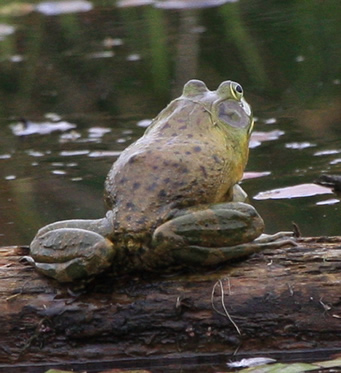

THE BULLFROG PROBLEM

Bullfrog (Rana catesbeiana), photo by Brian Klinkenberg
Bullfrogs are an introduced species in British Columbia. Since their introduction, they have invaded and become established in the Fraser Valley, and on the southeastern part of Vancouver Island.
Because they become very abundant in the wetlands they occupy, Bullfrogs are routinely blamed for the decline of native frog species in Western North America. However, while there is evidence that bullfrogs prey on other frog species, they are not solely responsible for the decline in other frog species. Evidence about their role in overall decline is complex at the very least. On this page we will compile information and references related to the "bullfrog question".
What stands out from the literature is that ecologists consider amphibian decline as a complex issue and the cause or causes are complex and require investigation. These possible causes range from climate change, ecosystem change and disturbance, increasing UV exposure, contaminants, invasive species impacts, pathogens, direct habitat loss, and combinations of these. There is no question that this issue requires more thought, and that further analysis of the problem is needed.
In BC, there is research-based evidence (range changes) that indicates that bullfrogs have displaced two native species on Vancouver Island: the Red-legged Frog (Rana aurora) and the Pacific Chorus Frog (Pseudacris regilla). Researcher Purnima Govindarajulu at the University of Victoria is now exploring how to halt this, and how to work towards intact habitats as a means of controlling invasions:
"The Project is focused on public outreach, site monitoring and steward training to prevent Bullfrog range expansion. The Project is also researching methods to mitigate the impact of existing Bullfrog populations by restoring habitats to enable the co-existence of native frog populations."
Other research shows that the displacement is not equitable on both species.
Overall, the deterioration of habitat may be one of the most critical factors that allows invasive species to become established, and in controlling invasions.
It is worth noting that the fungal pathogen (chytrid fungus) that infects bullfrogs in introduced locations, and which is spread by them to other frog species, does not infect them in their native range. Bullfrogs contract this fungus in new areas of establishment.
It is also worth noting that this fungus appears to have originated in southern Africa and appears to have been spread internationally by trade in the African frog species Xenopus laevis that began in 1938.
The following links provide background on this, and insightful reading on the overal bullfrog problem.
Links
List of articles on bullfrog ecology and their impacts on other species.
Correlated factors in amphibian decline: Exotic species and habitat change in western Washington.
Evidence for disease-related amphibian decline in Colorado.
Amphibian Population Declines at Savannah River Site are linked to Climate, not Chytridiomycosis
Asymmetical effects of Introduced Bullfrogs on Native Ranid Frogs in Oregon.
What Is Missing in Amphibian Decline Research: Insights from Ecological Sensitivity Analysis.
The effects of predatory fish on amphibian species richness and distribution.
Ultraviolet radiation, toxic chemicals, and amphibian population declines.
The origin of the Amphibian Chytrid fungus.
The amphibian decline crisis: a watershed for conservation biology?
The decline of Amphibians in California's Great Central Valley
Problems and opportunities managing invasive bullfrogs: is there any hope?
Please cite these pages as:
Author, date, page title. In: Klinkenberg, Brian. (Editor) 2021. E-Fauna BC: Electronic Atlas of the Fauna of British Columbia [www.efauna.bc.ca]. Lab for Advanced Spatial Analysis, Department of Geography, University of British Columbia, Vancouver. [Date Accessed]
© Copyright 2021 E-Fauna BC.